
|
||
|
Portland art blog + news + exhibition reviews + galleries + contemporary northwest art
|
||
Spring Cleaning Cluster Reviews This month marks my Twentieth Anniversary of moving to Portland and arguably that decision changed Portland in many ways (addressing history history with, Judd and Rothko, and a new appreciation of new media with Pipilotti Rist, Hank Willis Thomas and Cao Fei + talent scouting locals, etc). Simply put, I challenge Portland. There is still much more is to be done as the city doesnt effectively support its best and or most promising artists yet (other cities do it for us... but still cmon). Considering all this, I've been spending a lot of time looking at art, with a one night Spring Equinox show as well (it was very underground on purpose). As part of my spring cleaning process here is a cluster of reviews, with an eye towards exposing some common threads and themes. Key: "*" Indicates show still open and "**" indicates it is still open for today's First Thursday (yes PAM is open for First Thursday). As you can see Portland's art scene is far from dead, challenges sometimes strengthen things and I see evidence of it here.
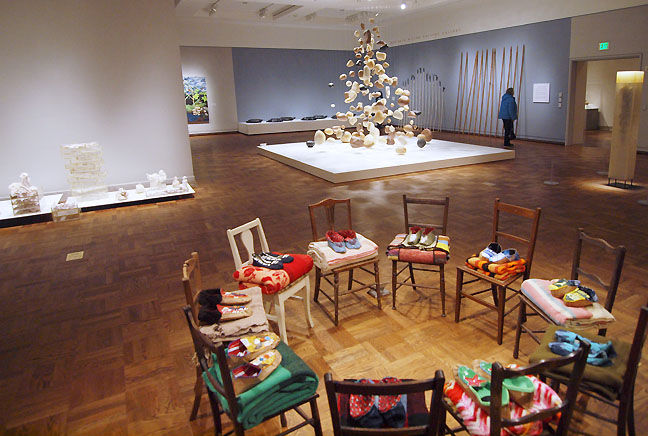 Main exhibition space of The Map Is Not The Territory with Charlene Vicker's Remember Redwing (fg) The Map is Not the Territory is the Portland Art Museum's revolving triennial replacement for the Contemporary Northwest Art Awards (which among artists was nicknamed the conservative art awards). For this program instead of a stereo typically "Northwest" approach to traditional materials and subject matter like rain, glass, trees and fetish of effortful handwork the show has thankfully taken on an anthropological approach, which is essentially an expose on the human experience. I found it more satisfying than the CNAA's or any of the other weak institutional regional surveys Portland has been routinely subjected to recently. Mostly that is because this show felt connected to the times rather than trying to ingratiate itself among various special interest patronage factions. In short the work felt personally involved rather than a checklist of token inclusions. Themes like border crossings, ancestors, roots, food, shelter and the uneasy dance of the natural and man made are all topical and relevant, if a little obvious themes to explore. Think of this a as a show where PAM evolves from merely a map to patronage to one that asks the broad question of, "What are we doing here?" One could think of The Map Is Not The Territory as a natural history museum approach to now. So, instead of dioramas of ice age hunters taking on a mammoth it reflects some of those you might meet on your way to a park, grocery store or the coast (there will be 2 more iterations, the next will be more inland). That said TMINTT is still far from truly edgy but at least it explores the boundaries that those in the northwest deal with on a daily basis. Does it reinvent the Northwest as some press statements promise? It decidedly does not. Does it reflect the variety and diversity of people in the Northwest? Sure, somewhat and with only 8 artists it is is inherently incomplete in an honest way. By comparison the 2016 Portland Now Biennial with its 34+ artists spread all over the state was an unwieldy mess of good intentions and mostly half-formed exhibitions that was simply spread too thin, leading to regime change at Disjecta. Nothing destabilizing here as TMINTT has fully realized works, mostly in thematic conversation with one another. 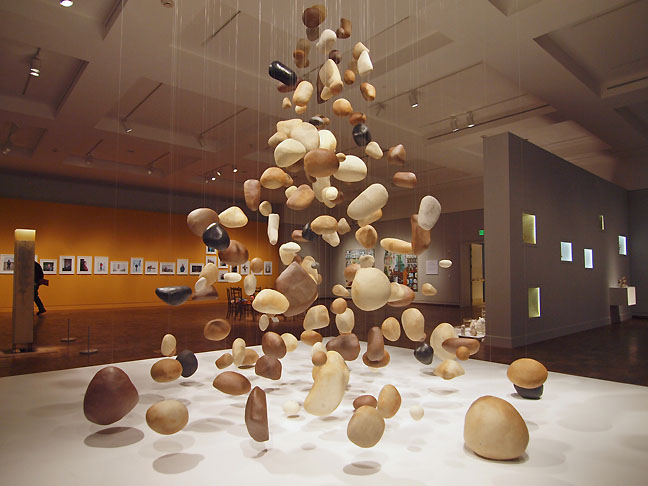 Annette Bellamy, Moving Mountains (fg)
Annette Bellamy, Moving Mountains (fg)
Still, PAM's new show's focus on diversity makes it politically very safe as a series of acknowledgments. All of which are are unsurprisingly overdue as the previous CNAA's focus on northwest art stereotypes felt like a suffocating cavalcade of what was found in Portland's viable but somewhat conservatively bourgeois commercial gallery scene. Thankfully, curator Grace Kook Anderson seems to have gone out of her way to avoid the usual suspects (instructors at NW art schools) and even artists who teach like Robert Rhee and Henry Tsang dont come off as insular practitioners. Quite the opposite. 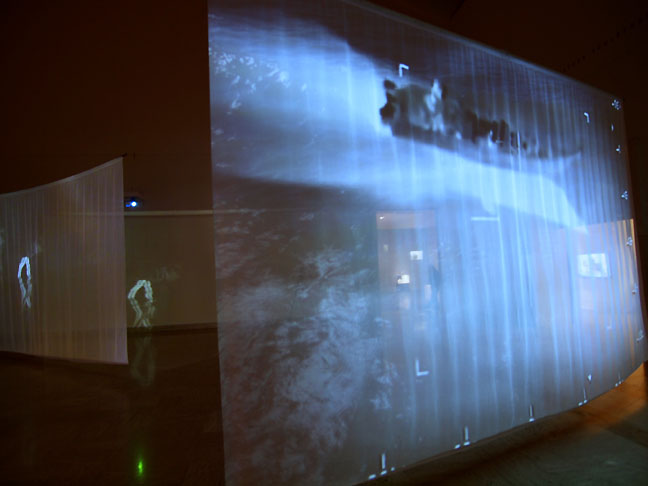 Fernanda D'Agostino, Borderline Fernanda D'Agostino, Borderline
Though kept subtle, much of the show's provocative edge comes from the opening large scale video installation by Fernanda D'Agostino called Borderline. In it spectral forms (including the outlines of museum visitors) traversing space under cover of darkness as well as tumbles of fleshy bodies roiling in fire and water allows the visitors to cut across space and perspectives. Boats carrying drugs under surveillance cross places where there will never be walls also expand upon her Open Signal show last year. Overall, Borderline doesn't judge, it simply records the desperation and invites the viewer to join the spin cycle of diaspora. It is the strong opening move of the show and the most memorable... presenting human desperation and need to move as a constant aspect of being human. I see this as a message, everyone in the Northwest is an immigrant or descendant of one and not always under idyllic circumstances. Ultimately, this portion of the show in the soaring indoor Schnitzer sculpture court is spectral and expansive, whereas the rest of the show feels more grounded, confining and yet more personal. The rest of the exhibition takes place in one of PAM's main exhibition galleries behind the sculpture court and what is a little disappointing after such a strong start is the way much of the work hugs the perimeter walls, similar to the way ancient sailors stayed withing sight of land. The most obvious work that thankfully bucks that lack of spatial nerve is Annette Bellamy's Moving Mountains, which comes off like a mound of river rocks tossed and suspended in the air. This is a good metaphor for the way people and even the land itself moves and changes their seemingly arbitrary definitions. Whereas, a sculptural clan of turtles and an array spears by Charlene Vickers seem to hang out on shores of the gallery's perimeter. Vickers install is a missed opportunity, especially the turtles... which seem to be coming from and going to nowhere and not in a good way. 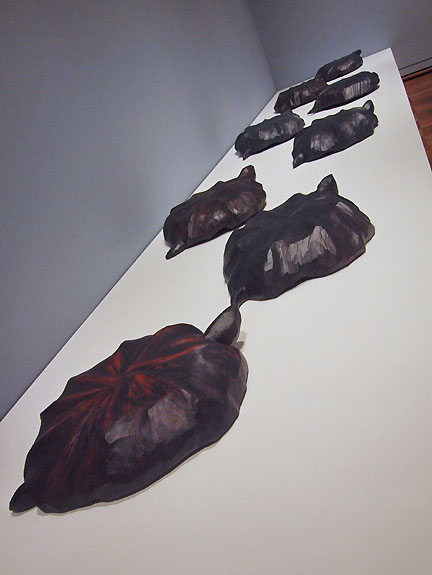 Vickers Clan of Turtles installed in TMINTT A tad better exhibition design and Vickers turtles and spears would have felt more akin to the migratory adaptation that animals and hunters have always shared (Vickers Urban Shaman show in Winnipeg did this better). Similarly, Ryan Piece's strong paintings that explore ecological and dialogical disaster/opportunities get a little lost in the space. Another highlight Vickers ring of chairs (Remember Redwing) and Pierce's literature along with Mary Anne Peters explorations of Middle Eastern histories all feel like a great bookclub that never get to fully convene. At least Irene Miller's personality infused photographs and Henry Tsang's multimedia work arent diminished by this hang but I feel like their participation in such a bookclub meetup could have added spark to the whole exhibition rather than just being off by themselves. True, group shows are incredibly tricky things to install but this exhibition almost begs to be more like a library or a park than a museum. That said its hard to fault a museum for thinking like a museum but it IS exactly what museums need to do today... evolve their engagement and their appointment of space matters a great deal. Thus, if D'Agostino's install successfully acted like a border at night under surveillance (an inspired choice) ... then I wonder why PAM didnt get up a little more nerve and look at the the rest of the exhibition less like a map with the walls acting as defacto borders? At least the off-site and extended programming around this show feels like it is moving in the right direction but some of the formal installations at PAM simply fell short. For example, Mary Ann Peters has done some my favorite installations in the Northwest and yet her corner of the show feels stillborn, even more than Vickers lost tribe of turtles. 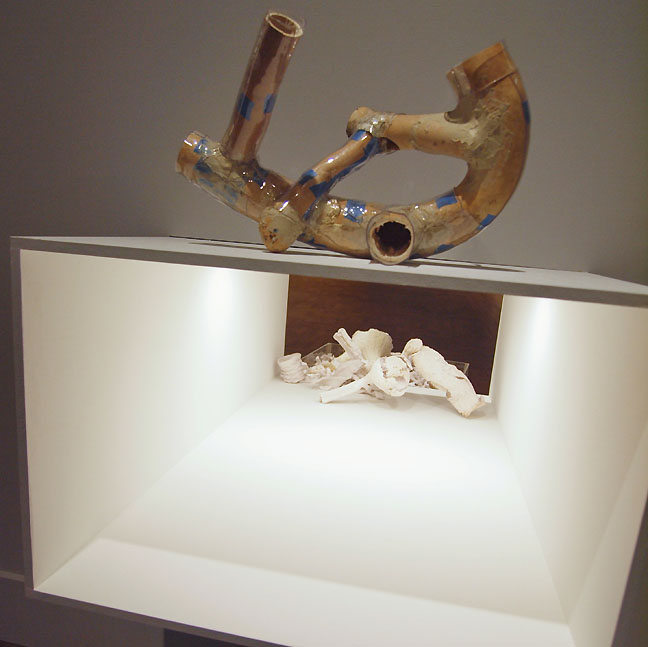 Rob Rhee at TMINTT That complaint aside the work that made the best use of the walls were Rob Rhee's Occupations of Uninhabited Space set into a wall and a new installation that bursts through that wall barrier. Rhee makes gourds that strain against their metal cages as well as presentations of tumbling fragile artifacts in plastic boxes that convey just how delicate most things and people are. Rhee's work here felt fresh and I see this as the Portland Art Museum trying to deal with the uncertainties of the moment and adding some institutional critique. In many ways its the most successful work in the exhibition as it reveals just how artists will evolve their work in whatever grotesque ways necessary to confront and illustrate the challenges of the world we live in. Rhee's installation is poetic too, like visiting the volcanic grave site of Pompeii, where forms struggle against their constraints. Rhee's work illustrates the fetters of art, humans and the museums that serve them. His fragile entropy/growth art seems like the breadcrumbs of human disruptions, disasters and migrations that also lead to new civilizations. All of which leads me to ask, can the Northwest be a new place? As water becomes more scarce it seems like the soggy Pacific Northwest is an oasis? This draws new people and as one of the arts minded people who moved to Portland in the late 1990's I felt that sense of diaspora. We changed Portland into a far more active visual arts center and though this show is not about Portland per se, I would have liked it to feel more like the turbulent Portland I live in. That historic subject remains to be dealt with effectively and waiting for a museum to do it is probably too much to ask. Its a good thing that PAM now feels like we should make these kinds of demands though, eh? Major group shows are usually let downs and somehow though TMINTT isnt a triumph it feels like its finally making an effort worth engaging. 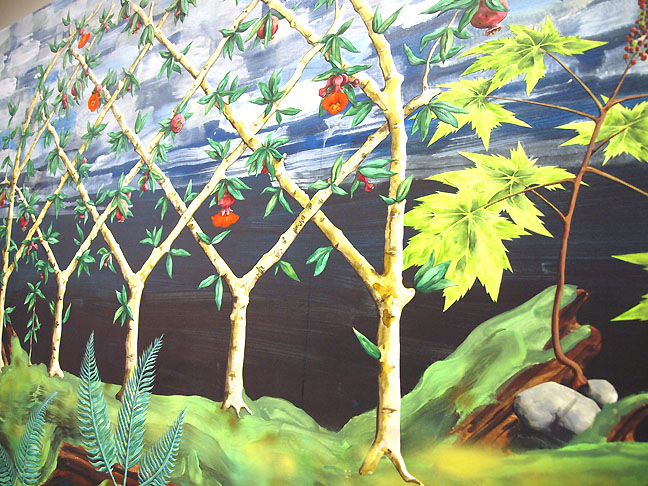 Detail of Ryan Pierce's Wierd Nurse, which begged for closer dialog with Bellamy, Vickers and Rhee's work The question at The Map Is Not The Territory is though it reflects some of the diversity we find in the Pacific Northwest... does it fully engage the sense of vitality and friction this constant influx of people creates? That's a tall order and are these new people really participating? Is participation enough? Where is is the momentum and tensions of our age here? Those questions whisper in much of the work in TMINTT but there is a crisis of uncertainty at this moment that feels underrepresented, a tension that this show seems to soften. Lets just say the gestalt of the show is a bit of a campfire singalong of kumbaya (something I did a lot of as an Eagle Scout so its very recognizable)... but there is also a sublime vastness of the unknown out there that art can address and doesnt here. Where is the terror of the moment we are in and the opportunities for change (good and bad) it can entail? Maybe we are inundated with that terror too much already and TMINTT simply brings us back to human scale? Exploring that tension is probably for another show and as a first installment of a series PAM gives itself time to learn what it still needs to present here. The message is pretty simple, the Northwest Coast is not homogeneous and remains full of immigrants or the descendants of them. Sometimes evoking the raw heat present in the social frictions of the day can shut down discussion and as an opening move, despite stutter steps The Map is Not The Territory is something worth seeing multiple times. the map is not the territory February 9 – May 5 Portland Art Museum 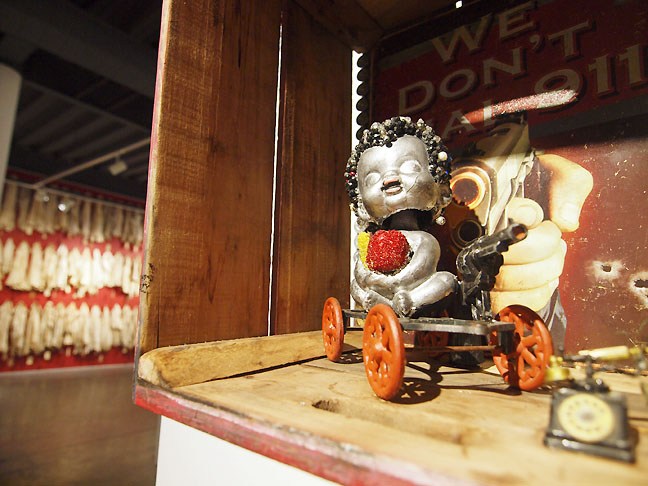 Willy Little (fg) and Reneee Billingslea at Archer Gallery Another anthropological show that does get to the edge and friction of the age is America's Whispered Truths at the Archer Gallery. In this duo exhibition Renee Billingslea and Willie Little dont pull any punches as they each explore the not so subtle violence of racism. Of the two Little is a little more campy and dipped in pop culture with works like Questions Later, Balckadamy Award and Pandoras Box, which is filled with Cracker Jack advertisements. 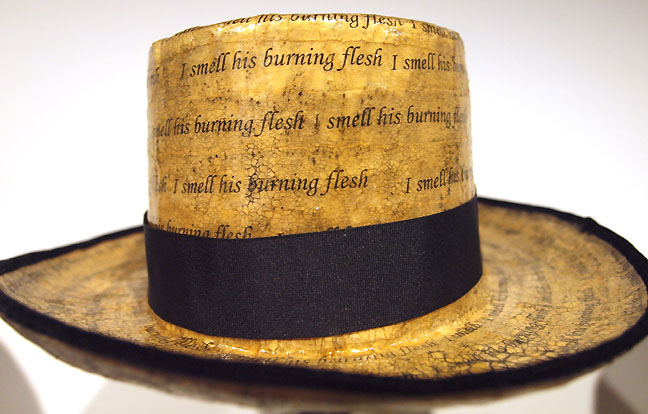 Billingslea, Lynching Hats (detail) Yet it is Billingslea who ends up hitting hardest. With Her Lynching Hats, Ties and Shirts pieces the sheer seriousness and repeated tragedies bourn of a system that allowed this to happen becomes evident. With so many hard hitting pieces the piece that brings it all together is Billinglea's Tar and Feathered suit. To the uninformed tarring and feathering might seem funnier and less evil than lynching but in fact the tar would burn the skin so badly that in a world without antibiotics it would ensure a slow humiliating death. In short, tarring and feathering was a weapon of terror and Billingslea's choice to create a suit that visitors can project oneself into goes beyond the Beuys-esque association. Instead, it is a haunting museum piece... for a museum with the cajones. If you want a truly unvarnished yet nuanced exhibition, America's Whispered Truths screams in silent terror, giving scope and sobering scale to the whole discussion of racism in America. America's Whispered Truths February 19 - April 13 Closing Reception: April 13, 3-5PM Archer Gallery Clark College, Vancouver WA. 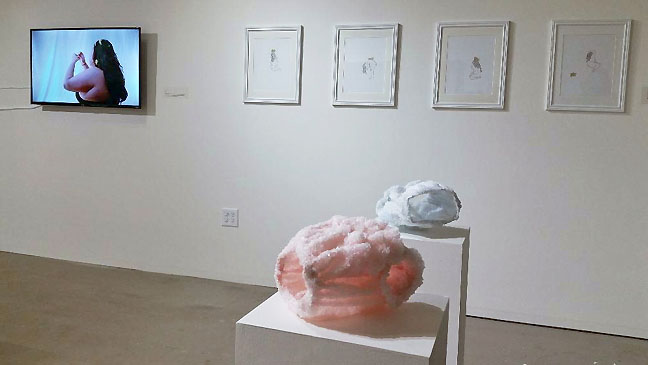 Kayla Wiley at Fuller Rosen One of the most promising young artists at work in Portland is Kayla Wiley, whose recent solo show Ego Placebo at Fuller Rosen was one of the most adventurous debuts we have seen in a while. She's already given a seminar on the importance of orgasms and Im a big fan of her crystallized baby clothes... presenting them equally as the prisons of parenthood and objects of adoration they signify. That's an incredibly loaded territory to make work and I like her ambition. Her video and performances of crushing things between her thighs are just another example of her take no prisoners approach. In fact, all of her work deals with the body and its territory of control makes her an important voice in Portland's art scene (which seems to reward more mainline Hilary Clinton supporter art that doesnt rattle all cages and just loves babies). Thing is Portland is a radical hotbed and Kayla Wiley is the kind of artist that finds those thin red lines that we see in many Portland art institutions and proceeds to traverse them in a bulldozer... laying a path for new roads. She's still developing but Portland's often mild institutions should take note or simply get out of her way. Though the show closed a few weeks ago everyone should have Wiley on their radar. Ego Placebo | January 26 - March 15th Fuller Rosen Gallery 2505 SE 11, suite 106 (Ford Building) 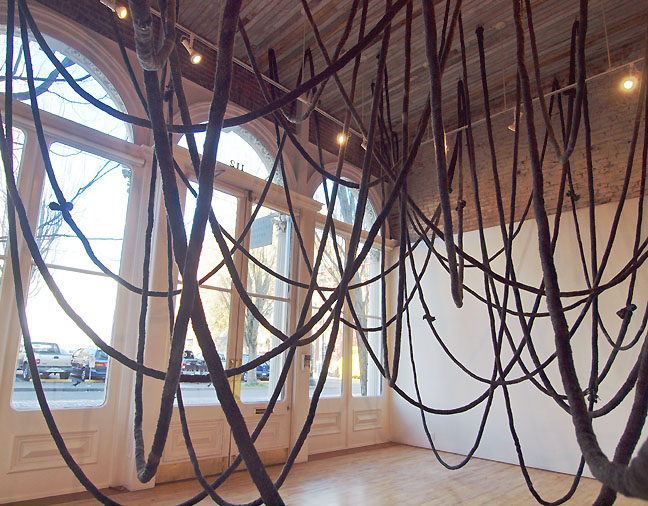 Heather Watkins at Front of House Front of House gallery is doing exciting things giving installation artists stipends and a venue to do very engaging work. The recent Drawing Room exhibition by Heather Watkins hearkens back to the old days of the Dia Foundation's support of idiomatic site specific works. It is even in a cast iron building, just like the Dia's early days in Soho. Here Heather Watkins did a good job of stringing odd graphite colored fabric/ropes in caternaries about the room. It feels old school, quoting from Eva Hesse, Robert Morris and maybe some Jasper Johns but the sheer fact she installed it with no obvious clear path to the open creative office behind shows both some of her verve and the host's willingness to engage the art. With the Portland Building Gallery closed for remodel (and hopefully an upgrade) as well as the loss of adventurous installation art friendly venues like NAAU, The Manuel Izquerdo gallery at PNCA and Haze this space fills some of the gaps they have left. We could use more. Drawing Room | January 30 - March 15, 2019 Front of House 112 SW 1st ave 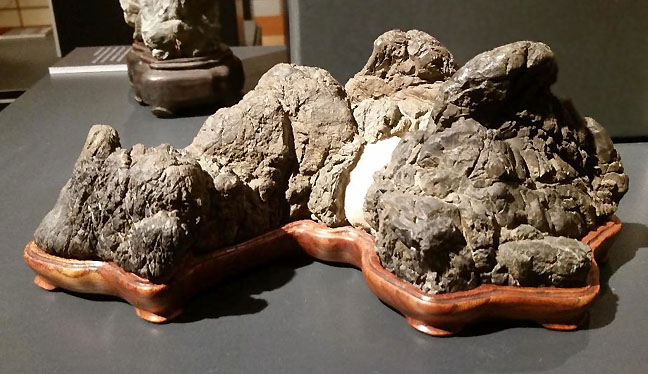 Viewing Stone at Portland Japanese Garden *Ice & Stone: Suiseki Viewing Stones from the Huntington & Hokkaido Photographs by Michael Kenna at the Portland Japanese Gallery may have been just be the nicest excuse to visit the Japanese Garden as Spring unveils itself. Drawn from one of the finest viewing stone collections in the world at the Huntington Library and Gardens in Pasadena California the stones are landscapes in miniature and designed for contemplation. Called Suiseki, Ive always been drawn to the way these tiny specimens allow us to shift our own sense of scale and place in the world. They are a perfect pair with the sublime Hokkaido photographs of Seattle's Michael Kenna. Ive long admired his fastidious darkroom technique and its interesting how the shadows and tones pair so well with the viewing stones. Yes the world is in turmoil but it is important to understand how to leave that behind and catch one's breath a bit and this exhibition is exactly the sort of balm we need more of. Some of the show is still up at the Tanabe Gallery in the new expanded garden grounds and the fact that the cherry blossoms are blooming is a good consolation prize for having missed the larger exhibition in the main gallery. Ice & Stone: Suiseki Viewing Stones from the Huntington & Hokkaido Photographs by Michael Kenna February 9 - March 24 with some works at Tanabe gallery through April 7 Portland Japanese Garden 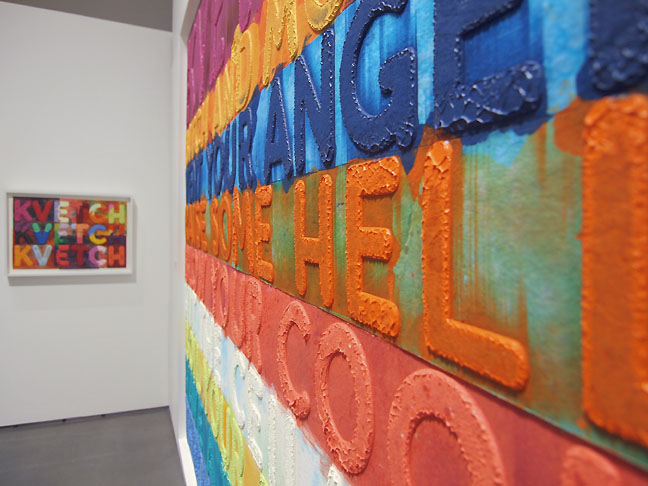 Mel Bochner at OJMCHE **Enough Said, a well titled exhibition of Mel Bochner's print art showcases his gift for exploring systems of understanding at the Oregon Jewish Museum and Center for Holocaust Education. Considering the exhibition is word art most visitors will find the visceral nature of the prints to be a surprise. Bochner is a master of taking physical schema then compounding it with systems of understanding. Perhaps the best example of this is the enormous print Kvetch, which starts eponymously at the top moving through, "vent your anger" eventually corroding into, "throw a shit fit". In this internet driven age where most words are easy to misconstrue or take in the most hostile way possible Ive always liked how Bochner essentially lights the wick of language till it detonates in an unstable explosion. What art can do is give permission to be human and Bochner's exhibition in Portland does that so well. I want to delve into this exhibition much deeper as the exhibition wears on... till then make certain you catch this excellent exhibition. Lets just say this is art that explores the comportment of language in the face of continued corrosion of self control among the humans who use it. Mel Bochner | Enough Said from the Collections of Jordan D. Schnitzer and His Family Foundation March 7 - May 26th Oregon Jewish Museum and Center for Holocaust Education Posted by Jeff Jahn on April 04, 2019 at 13:07 | Comments (0) Comments Post a comment Thanks for signing in, . Now you can comment. (sign out)
(If you haven't left a comment here before, you may need to be approved by
the site owner before your comment will appear. Until then, it won't appear
on the entry. Thanks for waiting.)
|
| s p o n s o r s |
 |
 |
 |
 |
 |
 |
 |
 |
 |
 |
 |
 |
 |
 |
 |
 |
 |
 |

|
Site Design: Jennifer Armbrust | • | Site Development: Philippe Blanc & Katherine Bovee | |

